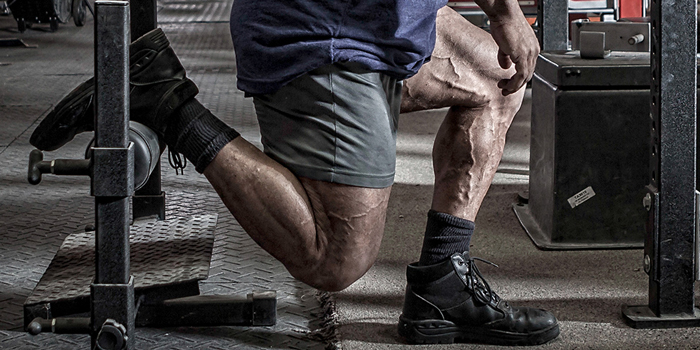
RFESS — An abbreviation seen in almost any strength and conditioning program, confusing novice lifters and striking uneasiness in intermediates as the looming thought of having "to do the left leg" comes to mind after one set has already taken away full knee extension in their right.
The split squat, most commonly used where the back foot is rested on a platform while the front foot does all the work (RFESS), should be performed by any athlete who would benefit from increased leg strength. So, in other words, it should be performed by any athlete. It has a myriad of benefits, from improving knee stability, to preventing injuries, to aiding hypertrophy in the glutes, hamstrings, and quads. The split squat, however, establishes its full form when both variations of the exercise are performed and all branches are utilized efficiently through proper technique and programming.
RELATED: Alternatives to Squat Training After Overuse Injuries
The front foot elevated split squat (FFESS) is a variation of the split squat that is far under-utilized in today’s world of strength training. As the name describes, this variation has the athlete’s front leg on a platform while their back leg is on the ground. It has very similar benefits to the RFESS, including improvement in knee stability and improved strength and hypertrophy in the quads, glutes, and hamstrings. However, used correctly and in conjunction with the RFESS, there are a host of benefits that are unique to the FFESS.
Shin Angle and Its Effect on Lower Limb Biomechanics
The true benefit of the split squat is found when the shin angle and how it changes in relation to each variation is delved into. The shin angle is a very well discussed topic in terms of the bilateral squat. The front squat has a smaller shin angle (in relation to the ground), leading to a larger recruitment of the anterior chain (quads, abdominals, etc.), whereas the more perpendicular shin angle (to the ground) in the back squat will generally lead to a larger recruitment of the posterior chain (glutes, hamstrings, and low back).
This concept is mimicked very closely when discussed with the split squat — and when used in relation to one’s bilateral squat technique, the most benefit is found. The RFESS is where the person’s shin is at a large, almost perpendicular angle to the ground, and hence has the most posterior chain recruitment. Certain variations of the RFESS can even further this level of posterior chain recruitment, which I will discuss more later in this article. In contrast to this, the FFESS puts the person’s shin at a small angle in relation to the ground, thus recruiting more anterior chain.
To unlock the full potential of the split squat and its variants, they must be utilized and programmed with respect to the lifter's squat technique. People generally fall into two categories when discussing squat technique:
- An anterior chain dominant squat, where one’s posture is very upright with limited change in torso angle throughout the movement. This kind of squat generally sees the knee have a very minute amount of backward travel through the concentric phase. This is seen in people who have a very strong anterior chain, yet may be lacking in posterior chain strength.
- A posterior chain dominant squat, where torso angle is subjected to a large angle change from the bottom of the concentric portion to the midpoint of the concentric portion. Within this type of squat, people’s knee will generally track back in the first half of the concentric and more emphasis will be placed on the hamstrings, glutes, and lower back than the quads and abs.
Being posterior chain or anterior chain dominant both have their advantages and disadvantages. However, knowing how to use the split squat and its variations in regards to one’s specific squat technique will be of great advantage to the coach and athlete when programming and the building up weaknesses.
The Variations and How They Differ
The more under-utilized of the two types of the split squat is the FFESS, which is where the most benefit is seen for the posterior chain dominant athlete. The two primary variations of the FFESS are the elevator and the escalator FFESS (elevator being the most quad dominant variation of all variations of the split squat).
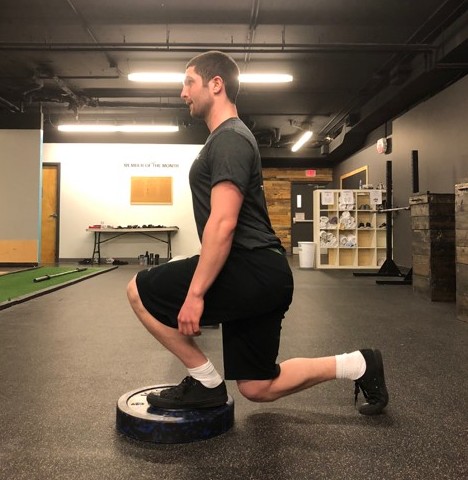
Elevator FFES — The elevator FFESS is where the knee of the back leg touches or almost touches the platform that the front leg is on. This allows for a large amount of ankle dorsiflexion, reducing the shin angle of the front foot and thus increasing quadriceps recruitment. This variation will transfer greatly to a posterior chain dominant squatter looking to improve quad strength specifically.
Escalator FFESS — The escalator FFESS is where there is a larger amount of distance between knee of the back leg and the platform the front leg is on. This variation still allows for a large amount of forward knee travel and reduced shin angle, but not as much as the elevator FFESS. Because of this, the escalator FFESS still allows for a large recruitment of the quadriceps, but recruits more of the posterior chain than the elevator FFESS.
The RFESS is the most commonly used split squat, but its different variations are not always utilized to their full extent. The common RFESS is where the athlete’s back leg is on a bench or platform, while the front foot is reached far out on the ground. This position allows for a more perpendicular shin angle than the FFESS, thus recruiting more posterior chain involvement than the FFESS.
The RFESS can also be made more posterior chain dominant by raising the level of the front foot. This position increases the angle of the shin in relation to the ground and increases the range of motion. Together, these have the most posterior chain recruitment of any variation of the split squat.
Programming and How to Utilize the Split Squat to Its Full Potential
Until an individual masters the split squat, it should be heavily present in the majority of people’s programs. As discussed earlier, the variation of the split squat used should primarily be chosen for an individual and their particular body type and movement patterns. However, all variations of the split squat can be used to some extent by every individual.
As Louie Simmons and other advocates of the conjugate system regularly promote, the law of accommodation is always present. And although one will see the benefit of focusing primarily on the split squat that is most relevant to them, cycling through the variations in a well structured and programmed manner will always be the most beneficial way of using the split squat.
The split squat will most frequently be used as the primary lower body assistance exercise. However, it can also be used in place of the squat as the prime movement for dynamic effort work (in a conjugate-based program) in athletes who predominantly have to push off one foot. An example of this can be seen in WS4SB by Joe DeFranco, as he often uses eccentric-focused split squats as the primary movement on an athlete’s dynamic (or in these terms, eccentric) effort day. As a side note, DeFranco does generally add some plyometrics to make up for the lack of dynamic work if he uses the split squat as the primary strength-based movement.
If the split squat is being used as either an accessory or a primary movement in someone’s program, the overloading of the movement should be performed in a similar fashion to dynamic effort or repetition effort work (depending on the emphasis of the program). If it is in the place of a repetition effort type exercise, a specific variation of the split squat should be solely performed for a number of weeks (three to six). The load should increase from an RPE 5 or RPE 6 in the first week all the way to an RPE 9 or RPE 10 in the final week. The rep ranges should be between eight and 20, for two to five sets. Once an RPE 9.5 or RPE 10 has been performed, you have found your limit in regard to how far you can currently push the variation of the split squat. At this point, the program should always revert back to RPE 5 and RPE 6 while using a different form of split squat. This is how to prevent staleness and keep allowing for overload.
MORE: Correcting Asymmetries: Unilateral Work Versus Integration
If the split squat is being used in place of a primary movement on an eccentric (in place of a dynamic) effort day, the main focus should be ensuring the eccentric portion of the lift (the lowering phase) is at least five to six seconds per repetition. The rep ranges here will be lowered (three to six) and the sets will range from four to 10.
The structuring of the programming to allow for one’s weaknesses is quite simple: if a person is a quad-dominant athlete, he or she might focus on the front foot raised RFESS for a period of six weeks, which might be followed by a four-week period of a regular RFESS, which might then be followed by a three-week period of FFESS. Following the conclusion of the third period, the person could again do a period focusing on the front foot raised RFESS. With this setup there are certain periods of time spent on developing all variations (which will all complement each other) but 10 of the 13 weeks are spent developing the athlete’s weaker variation. It is important to use a number of split squat variations for optimal benefits, but how much each variation is emphasized will differ depending on the athlete.
Conclusion
The benefits of unilateral work—both upper and lower body—are more than well known, and by not having it in your program, you’ll be missing out on a huge number of benefits for injury prevention, hypertrophy, and strength development. Using different variations of unilateral work, not dissimilar to other facets of any strength program, is of utmost importance to the continued development of the athlete. For this reason, having many forms of unilateral strength-building exercises is essential, and learning how to implement the correct ones at the correct times will put you ahead of the game.
Noel FitzGibbon is a former international, underage level weightlifter who has represented Ireland at a European level and has achieved a World Ranking with the IWF. He has coached in strength and conditioning and weightlifting/powerlifting at a provincial, national and international level. He is currently working as a personal trainer and a strength and conditioning coach out of Calgary, Canada.









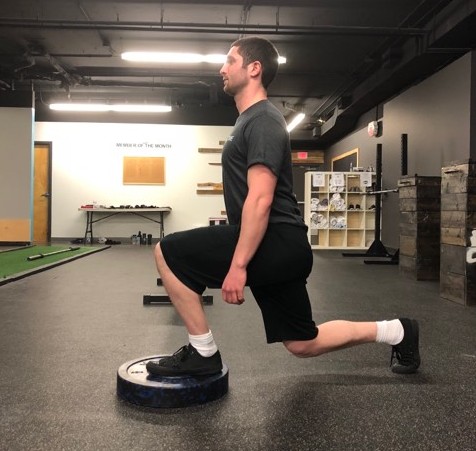
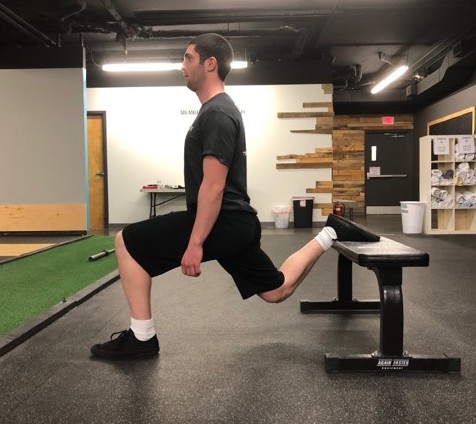
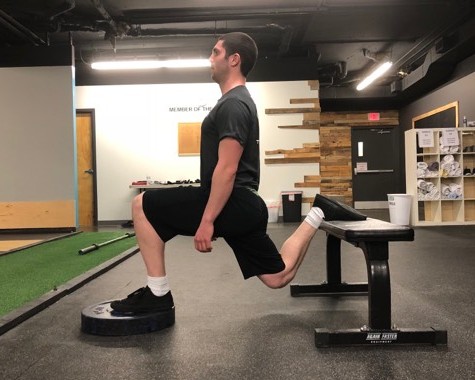

Interesting outline and very good reasoning.
How would you standardize the depth of each repetition? Considering work = force * distance, you need to somehow ensure the same depth is achieved in each repetition.
From the images it doesn't become clear to me.
Thanks and all the best,
Christian.
Is your question in regards to standardizing depth within one set of split squat variations or in regards to standardizing depth between each split squat variation?
The standardization of depth, in regards to one specific variation will change depending on the individual. Similar to how a full range of motion back squat might not be ideal for every individual, the full range of motion split squat may also not be ideal, depending on co-ordination, balance, mobility etc.
How I have standardized it this way is by placing a number of plates beneath the back leg of the person, the number of plates depending on how comfortable the person's range is. The person will just go down until the back leg touches the plates. As the person becomes more strong, balanced etc., I will remove plates until full range can be achieved.
If you are asking about how to standardize depth between the RFESS, the FFESS etc., I would actually stray away from perfectly standardizing range on these movements. work does equal force x distance, but I feel looking at any exercise from a purely physics standpoint leaves a lot of information unused.
Full range on the FFESS (to where a near maximum quad stretch is reached {aside from the rectus femoris, which of course won't reach a full stretch, given the hip flexion being performed)} will have a higher femur angle (in relation to the ground) than the RFESS, given the higher hip flexion needed to sufficiently stretch the glute. In this manner, much like the front squat to the back squat, I feel each variation of the split squat should really be taken as its own exercise.
In short, full range should really be seen as where the person's quad/glute feels to be in a sufficiently stretched position at the end range, Which will vary depending on the individual.
Thanks for the question and I hope the answer was what you were looking for. Let me know if I can help with anything else.
Ive just added in a variation of split squats from a John Meadows video in which he incorporates a hybrid of the above variations. (escalated with front foot elevated) Allowing a greater ROM in the glute.
Dropset
8 reps - 8 sec Iso hold
8 reps - 8 sec hold
8 reps (bw) - 8 sec hold
Honestly have never felt a burn like it!